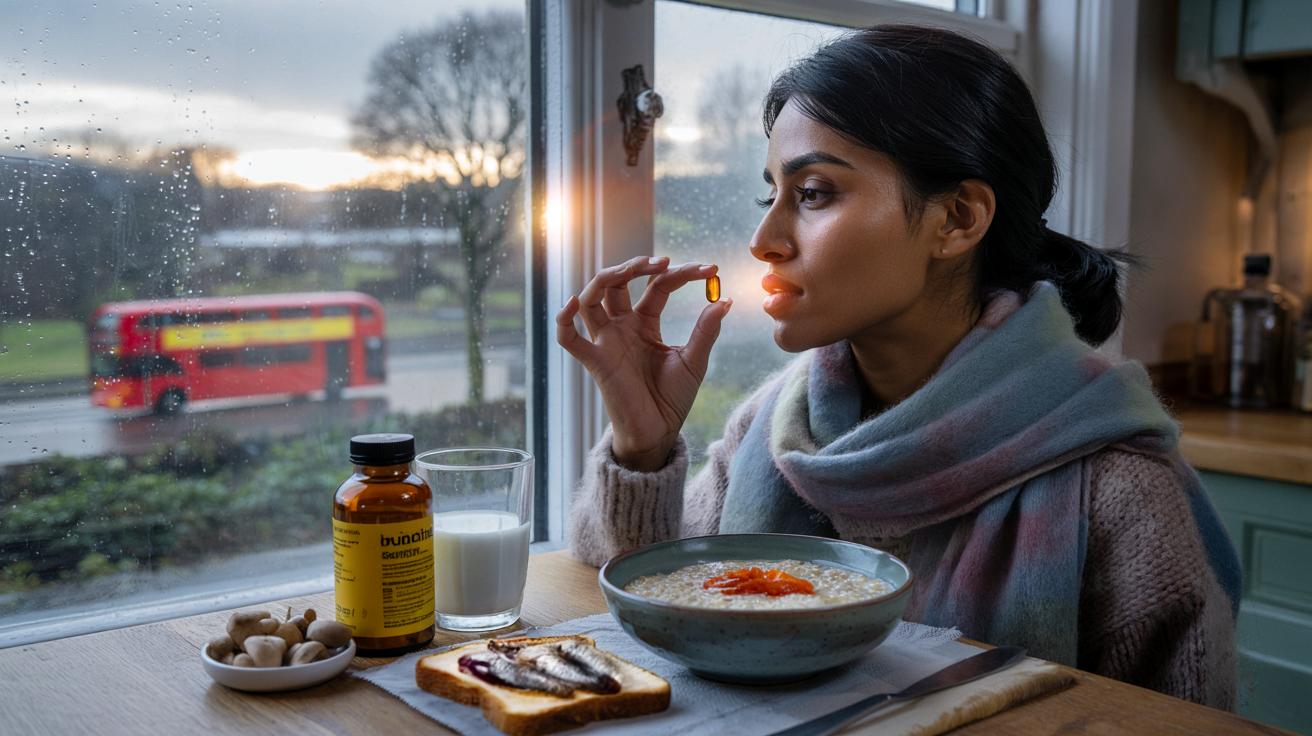Grey mornings steal the colour from the sky, coats get heavier, and energy seems to drain faster than the daylight. Colds circle like gossip, nails snap, moods dip, and sleep feels less restorative than it should. There’s a quiet culprit behind so many November slumps.
The bus heater fogs the windows as a woman in a wool scarf taps her Oyster card and stares at the faint sun, a pale coin behind the cloud. In the office, she eats porridge by a screen that glows brighter than the day outside, then walks home under street lamps that flicker before five. Small aches, a steady tiredness, a sense that coffee does less than it used to. The clocks didn’t just shift time; they shifted her body’s chemistry, one missing light signal at a time. It’s the sunshine you can’t see.
The invisible gap November brings
Call it what it is: **vitamin D** is the thing many women are running short on in November. The sun sits low and the angle means UVB barely reaches you at all in the UK. Winter coats cover skin, commutes happen in the dark, and lunch breaks are swallowed by rain. Your bones, muscles, immune cells and even mood circuitry use this nutrient like a language. When it fades, life feels heavier than it should.
Take Priya, 34, who works in an NHS scheduling office in Lewisham. By mid-November she was skipping her evening Pilates because her legs felt leaden and her motivation fell off a cliff. Her GP, familiar with that seasonal pattern, suggested a blood test and a simple daily supplement. She felt steadier by January. In the background, the UK’s own data echoes her story: roughly one in five people have low vitamin D levels in winter and spring, with higher risk if you have darker skin or keep most of your skin covered.
There’s a clean logic to it. The north-of-50-degrees latitude means the sun’s UVB is too weak from roughly October to March for most people to make vitamin D in skin. Food helps, but not much: oily fish, egg yolks and fortified milks offer only small amounts, and vegetarian choices are slimmer still. Melanin reduces vitamin D synthesis, city living limits daylight, and desk jobs do the rest. The body tries to coast on summer stores, then—bang—November arrives and the tank runs low.
How to top up without turning your life upside down
The simplest play is boring, which is why it works: take **10 micrograms (400 IU)** of vitamin D daily through autumn and winter. That’s the UK guidance for adults, including women who are pregnant or breastfeeding. Put the bottle next to the kettle or toothbrush and swallow it with your main meal, as fat helps absorption. If you prefer plant-based, look for D3 from lichen; it’s vegan and widely available. Tiny habit, big return.
Let’s be honest: nobody really does that every day. The trick is to lower the friction. Buy a three-month supply in one go. Set a phone reminder for the time you naturally pause, like after lunch. If you regularly forget, a weekly dose can be discussed with your GP or pharmacist. Don’t chase mega-doses on your own, and don’t exceed the UK’s safe upper limit of 100 micrograms (4,000 IU) a day. If you have kidney issues, take certain medications, or have a health condition affecting calcium, ask your clinician for personalised advice.
Food still counts, but think of it as a nudge, not the fix. A tin of sardines on toast, mushrooms exposed to UV light, fortified yoghurt or plant milks slipped into porridge. Your plate can support what the sky won’t.
“November is when vitamin D goes quiet in Britain,” says a London-based dietitian. “A small, consistent supplement bridges that silence for bone, immune and mood support.”
- Pick D3 where you can; vegan D3 exists and works well.
- Anchor the tablet to a daily cue: kettle, keys, or toothbrush.
- Eat oily fish once or twice a week if you enjoy it.
- Look for “fortified with vitamin D” on milks and cereals.
- If you cover most skin or have darker skin, speak to your GP about year-round needs.
What this means for your November
We’ve all had that moment when the early dark feels like it’s winning. The good news is you can change the odds with a habit so small it barely dents your day. Think of vitamin D as a winter foundation—quiet, unflashy, stabilising—so your energy, focus, and sense of steadiness don’t rely on rare blue skies.
It won’t fix everything. It can shift the background, the slow hum your body runs on as you stack work, family, and the life you’d still like to live when the sun clocks off at four. If you share a house, make it a household ritual, like tapping the lights off at night or topping the fruit bowl. One tiny pill, the same time, each day. In the gloom of November, that kind of predictability feels like a small act of resistance.
| Point clé | Détail | Intérêt pour le lecteur |
|---|---|---|
| Vitamin D drops in November | UK sunlight is too weak for skin synthesis | Explains why energy and resilience feel lower |
| Daily 10 µg works | Matches national guidance for adults | Clear, low-effort action to take now |
| Food supports, doesn’t replace | Oily fish, fortified milks, UV mushrooms | Easy tweaks that stack with a supplement |
FAQ :
- Can I get enough vitamin D from the sun in November in the UK?Not realistically. The sun’s UVB angle is too low for most of the UK, even at midday. Short outdoor time is still great for mood and movement, but it won’t cover vitamin D.
- Should I choose D2 or D3?D3 tends to raise and maintain blood levels more effectively. Vegan D3 from lichen is widely available if you avoid animal products.
- What’s the safest dose to take daily?For most adults, **10 micrograms (400 IU)** daily through autumn and winter is advised in the UK. Don’t exceed 100 micrograms (4,000 IU) a day unless your clinician recommends it.
- How soon might I feel a difference?Some people notice steadier energy within a few weeks, while others simply avoid the slow slide they felt in past winters. The body is topping up a low reservoir, which takes time.
- What if I’m pregnant, breastfeeding, or have a health condition?Stick with 10 micrograms daily unless your midwife or doctor advises otherwise. If you have kidney problems, sarcoidosis, high calcium, or take certain medicines, get personalised guidance first.
First Appeared on
Source link












